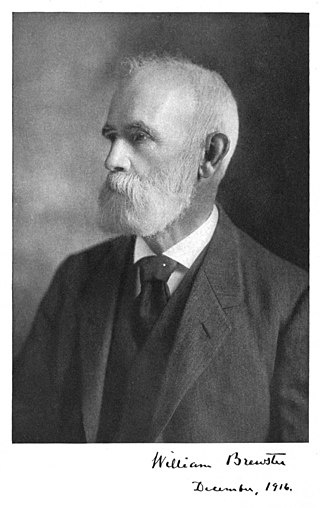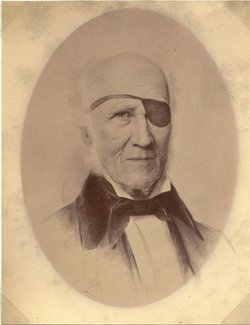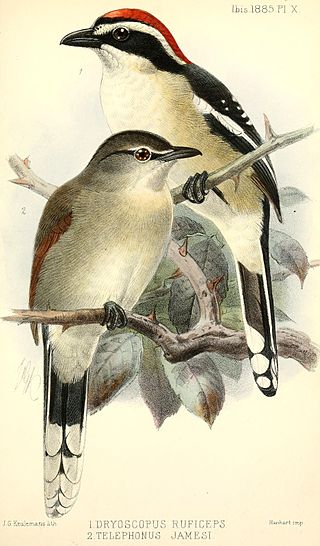
The Sandwich tern is a tern in the family Laridae. It is very closely related to the lesser crested tern, Chinese crested tern, Cabot's tern, and elegant tern and has been known to interbreed with both elegant and lesser crested. It breeds in the Palearctic from Europe to the Caspian Sea and winters in South Africa, India, and Sri Lanka.

The royal tern is a tern in the family Laridae. The species is endemic to the Americas, though vagrants have been identified in Europe.

Charles Barney Cory was an American ornithologist, golfer, outdoorsman, and author.

Robert Ridgway was an American ornithologist specializing in systematics. He was appointed in 1880 by Spencer Fullerton Baird, secretary of the Smithsonian Institution, to be the first full-time curator of birds at the United States National Museum, a title he held until his death. In 1883, he helped found the American Ornithologists' Union, where he served as officer and journal editor. Ridgway was an outstanding descriptive taxonomist, capping his life work with The Birds of North and Middle America. In his lifetime, he was unmatched in the number of North American bird species that he described for science. As technical illustrator, Ridgway used his own paintings and outline drawings to complement his writing. He also published two books that systematized color names for describing birds, A Nomenclature of Colors for Naturalists (1886) and Color Standards and Color Nomenclature (1912). Ornithologists all over the world continue to cite Ridgway's color studies and books.

Joel Asaph Allen was an American zoologist, mammalogist, and ornithologist. He became the first president of the American Ornithologists' Union, the first curator of birds and mammals at the American Museum of Natural History, and the first head of that museum's Department of Ornithology. He is remembered for Allen's rule, which states that the bodies of endotherms vary in shape with climate, having increased surface area in hot climates to lose heat, and minimized surface area in cold climates, to conserve heat.

William Brewster was an American ornithologist. He co-founded the American Ornithologists' Union (AOU) and was an early naturalist and conservationist.

Howard Saunders was a British businessman, who later in life became a noted ornithologist, specialising in gulls and terns.

The name marsh tern refers to terns of the genus Chlidonias, which typically breed in freshwater marshes, rather than coastal locations.

Ludlow Griscom was an American ornithologist known as a pioneer in field ornithology. His emphasis on the identification of free-flying birds by field marks became widely adopted by professionals and amateurs. Many called him "Dean of the Birdwatchers."

Henry Perkins Bryant was an American physician and naturalist. He collected specimens, particularly birds and mammals, from the Caribbean and North America. A number of subspecies were described from his collections and several were named after him including Bryant's Savannah Sparrow Passerculus sandwichensis alaudinus, Bryant's Golden Warbler Dendroica petechia bryanti, Agelaius phoeniceus bryanti and Bryant's Grassquit Tiaris olivaceus bryanti.

Thalasseus, the crested terns, is a genus of eight species of terns in the family Laridae.

Charles Johnson Maynard was an American naturalist and ornithologist born in Newton, Massachusetts. He was a collector, a taxidermist, and an expert on the vocal organs of birds. In addition to birds, he also studied mollusks, moss, gravestones and insects. He lived in the house at 459 Crafts Street in Newton, Massachusetts, built in 1897 and included in the National Register of Historic Places in 1996 as the Charles Maynard House. The Charles Johnson Maynard Award is given out by the Newton Conservators, Inc.

Walnut Hills Cemetery is a historic cemetery on Grove Street and Allandale Road in Brookline, Massachusetts. It encompasses 45.26 acres (18.32 ha), with mature trees and puddingstone outcrops, and was laid out in 1875 in the then-fashionable rural cemetery style. Many past prominent citizens of the town, including architect H. H. Richardson, are buried here. The cemetery was listed on the National Register of Historic Places in 1985.

Cabot's tern is a species of bird in subfamily Sterninae of the family Laridae, the gulls, terns, and skimmers. It is found in the eastern U.S. and Middle America, the Caribbean, Trinidad and Tobago, and in every mainland South American country except Bolivia and Paraguay.

Samuel Cabot Jr. was an American businessman in the early-nineteenth-century China Trade, a member of the wealthy and prominent Cabot family.

Frank Blake Webster was an influential ornithological publisher, taxidermist and natural history dealer in the late 19th century.

Birds described in 1885 include semicollared flycatcher, Palawan hornbill, blue bird-of-paradise, lesser lophorina, brown sicklebill, Comoros cuckooshrike, Cozumel vireo, Indochinese green magpie, three-streaked tchagra, Lawes's parotia, Turquoise-winged parrotlet
The Cozumel wren is a very small passerine bird in the wren family Troglodytidae that is endemic to the small island of Cozumel off the eastern coast of Mexico. The name troglodytes means "hole dweller", and is a reference to the bird's tendency to disappear into crevices when hunting insects or to seek shelter. It was formerly considered to be conspecific with the northern house wren.

Thomas Edward Penard was an American engineer and ornithologist who, along with his brothers studied the birds of Surinam. Along with his brothers, he also took an interest in folklore and linguistics in the Caribbean.
William Wood was an American physician and naturalist, best remembered as an expert on the avifauna of Connecticut.




















